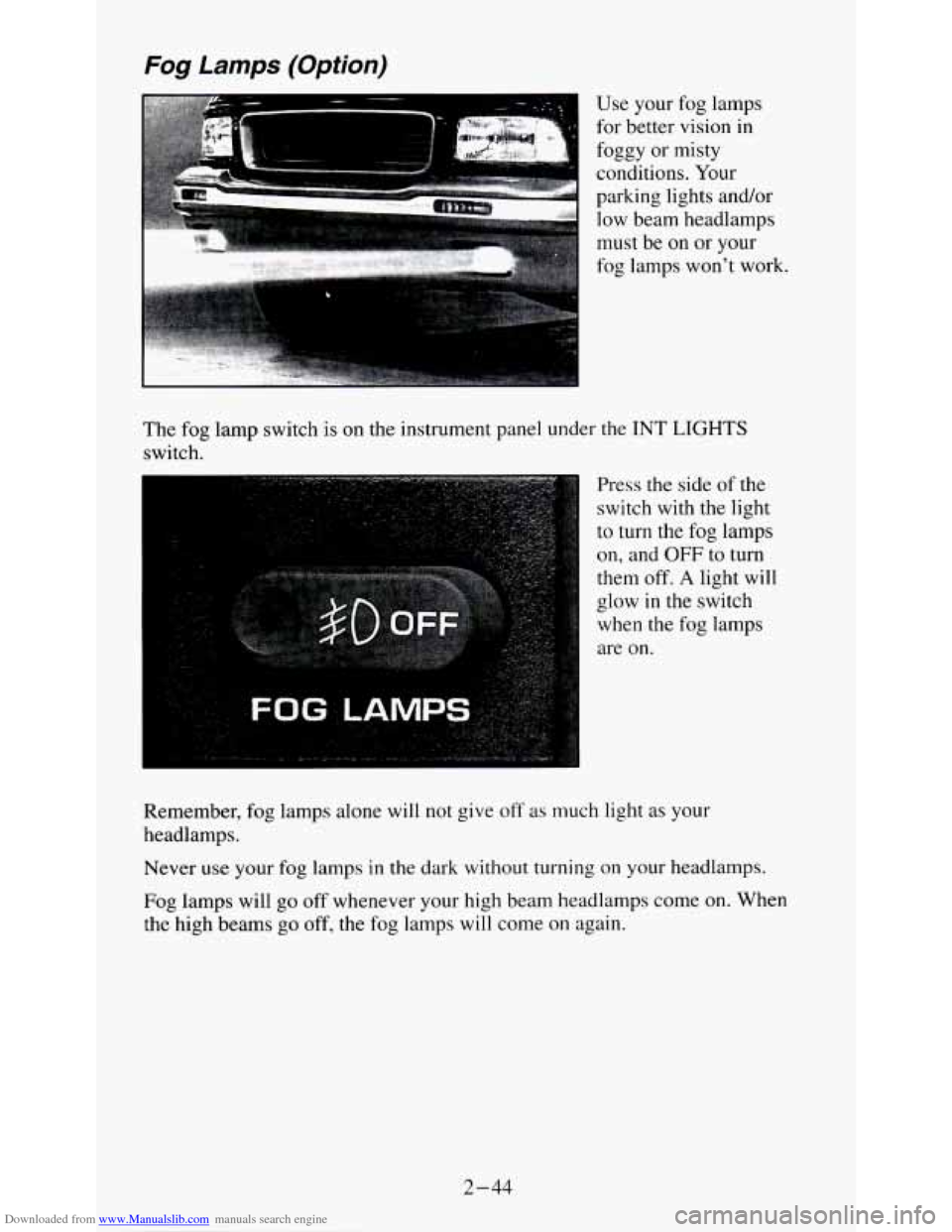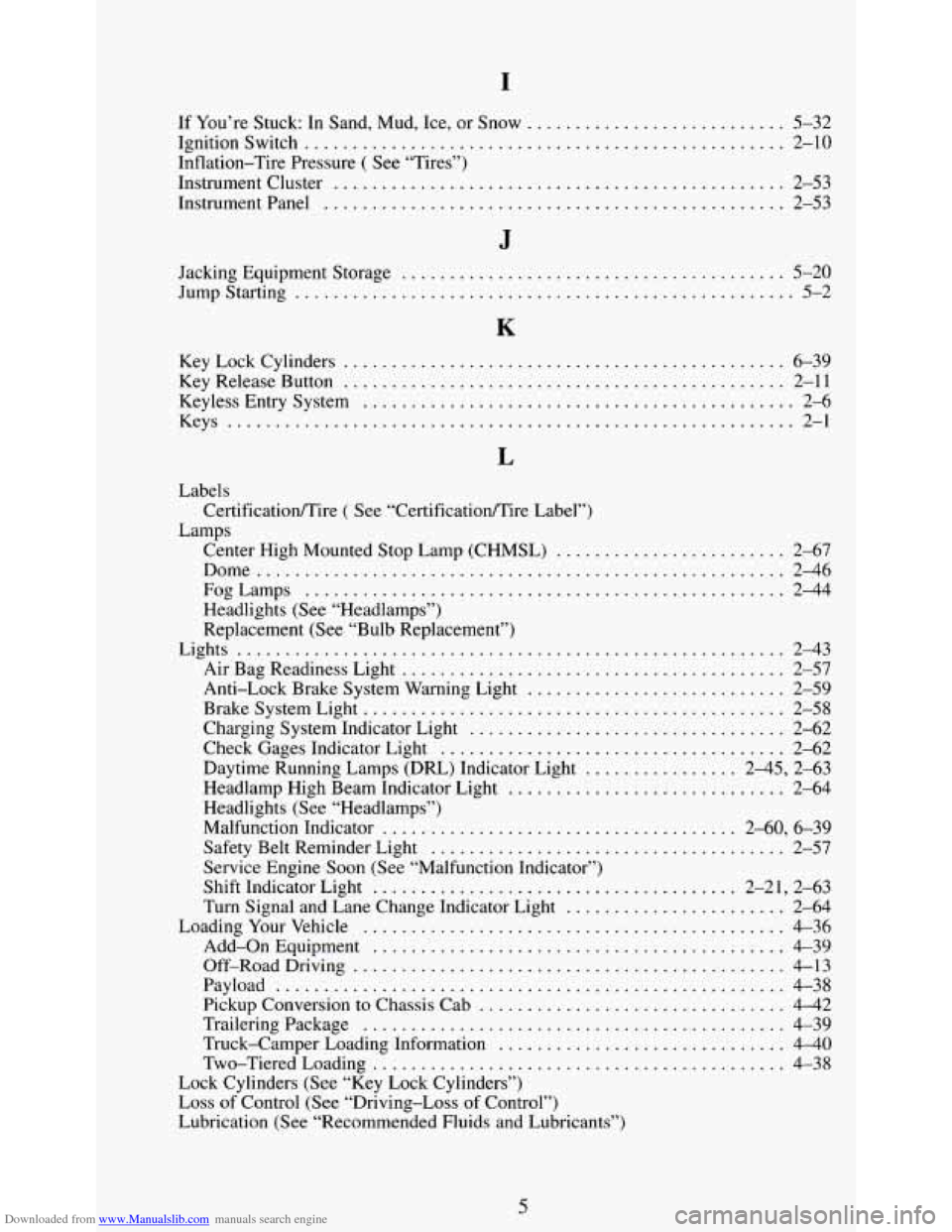fog light CHEVROLET S10 1995 2.G Owners Manual
[x] Cancel search | Manufacturer: CHEVROLET, Model Year: 1995, Model line: S10, Model: CHEVROLET S10 1995 2.GPages: 354, PDF Size: 18.92 MB
Page 7 of 354

Downloaded from www.Manualslib.com manuals search engine These symbols are important for you and your passengers whenever your
vehicle
is driven:
Fasten Safety
Belts
Door LockNnlock
These symbols have to do with your lights:
I Master Lighting
Switch Turn
Signal
Direction
A
Hazard Warning
Flasher Headlight
High Beam
Parking Lights Daytime
Running Lights
- Fog Lights Headlight
Low Beam
Vi
Page 89 of 354

Downloaded from www.Manualslib.com manuals search engine Fog Lamps (Option)
Use your fog lamps
for better vision in
foggy
or misty
conditions. Your
parking lights and/or low beam headlamps
must be
on or your
.. : L .ii$..I.'.%$:~>:. -,.-.:* . ',I.?: ,: ,, '*$+A& ., . ,, .. , ', . .. fog lamps won't work.
The fog lamp switch is on the instrument panel under
the INT LIGHTS
switch.
Press the side
of the
switch with the light
to turn the fog lamps
on, and OFF to turn
them off.
A light will
glow in the switch
when the fog lamps
are on.
Remember, fog lamps alone will not give off as
much light as your
headlamps.
Never use your
fog lamps in the dark without turning on your headlamps.
Fog lamps will go off whenever your high beam headlamps come on. When
the high beams
go off, the fog lamps will come on again.
2-44
Page 98 of 354

Downloaded from www.Manualslib.com manuals search engine lnstrument Panel
1. Vents
2. Instrument Cluster
3. Air ConditionerLHeater
4. Glove Box
5. Sound System
6. Power Aux Outlets
(Optional)
6. Cigarette Lighter
lnstrument Cluster
7. Brake Release Handle
8. Light Switches
9. Electronic Transfer Case (Option)
10. Fog Lamp Switch (Optional)
11. Ashtray
12. Storage Compartment
Your instrument cluster
is designed to let you know at a glance how your
vehicle is running. you’ll know how fast you’re going, about how much fuel
you’ve used, and many other things you’ll need to know to drive safely and
economically.
2-53
Page 115 of 354

Downloaded from www.Manualslib.com manuals search engine The lower knob changes the heater function and determines which outlets
the air will flow through (instrument panel, defroster, heater, etc.).
OFF - This setting turns off all heating functions. Some outside air will
still come out of the heater outlet whenever the vehicle is moving forward.
VENT - Airflow is through the instrument panel vents. Set the upper knob
to the temperature desired. This setting is useful for mild outside
temperatures, when little heating or cooling is desired.
BI-LEV - Outside air comes in through the heater floor vents and the
instrument panel vents. This setting is useful
in cool weather with bright
sunlight.
HEAT
- Heated air comes out through the heater floor vents and
windshield defroster vents. This setting is useful for cold weather.
BLEND - Airflow is divided equally between the heater floor vent and the
windshield defroster vents. This setting is useful
in cool weather when you
have fog
or ice on the windshield or side windows.
DEF - This setting directs most air through the windshield defroster vents
and some through the heater vents. This setting
is useful when you have fog
or ice on the windshield.
Heater/Air Conditioning Controls
If your vehicle has air
conditioning, your
heatedair conditioning
controls will look like
this.
Before using your vehicle's air conditioning, open the windows to clear the
vehicle of
hot air.
The switch with the fan symbol changes the fan speed. To increase the fan
speed, push the switch upward toward
HI. To decrease the fan speed, push
the switch downward toward
LO.
The upper knob changes the air temperature. Turn the knob clockwise for
warmer air. Turn the knob counterclockwise for cooler air.
3-2
Page 116 of 354

Downloaded from www.Manualslib.com manuals search engine The lower knob selects the heater or air conditioning function and
determines which outlets the air will flow through (instrument panel,
defroster, heater, etc.).
OFF - This setting turns off all heating functions. Some outside air will
still come out of the heater outlet whenever the vehicle is moving forward.
MAX A/C
- Air inside your vehicle is recirculated to maximize your air
conditioner’s performance and your vehicle’s fuel economy. This setting
cools the air the fastest and should be used to keep “unwanted odors” and/or
dust from entering the vehicle.
NORM A/C - This setting cools outside air and directs it through the
instrument panel vents. This setting is useful for normal cooling on hot
days.
BI-LEV A/C
- Air is delivered through the heater floor vents as well as
the instrument panel vents. This setting is useful in cool weather with bright
sunlight.
VENT - Airflow is through the instrument panel vents. Set the upper knob
to the temperature desired. This setting is useful for mild outside
temperatures, when little heating or cooling is desired. The air conditioner
does not run.
HEAT
- Heated air comes out through the heater floor vents and
windshield defroster vents. This setting is useful for cold weather.
BLEND
- Airflow is divided equally between the heater floor vent and the
windshield defroster vents. This setting
is useful in cool weather when you
have fog or ice on the windshield
or side windows.
DEF - This setting directs most air through the windshield defroster vents
and some through the heater vents. This setting is useful when you have fog
or ice on the windshield.
Engine Coolant Heater (Option)
If you use the optional engine coolant heater before starting your engine,
your heating system
will produce warmer air faster, to heat the passenger
compartment
in cold weather. See “Engine Coolant Heater” in the Index.
3-3
Page 283 of 354

Downloaded from www.Manualslib.com manuals search engine NAME
PWR ACCY
PWR WDO
STOP
HA2
HORN DM
T/L CTSY
CIRCUITS PROTECTED
Power Door Locks, Power Seat, Power Seat Lumbar,
RKE
Power Windows
Stop Lamps, Hazard Lamps, Chime, CHMSL Relay,
CHMSL Lamp
Dome Lamps, Cargo Lamps, Visor Vanity Mirror,
Cigarette Lighter, Inside Rearview Mirror Lamp,
Overhead Console Lamps, Glove
Box Lamp, Horns,
Horn Relay, IP Courtesy Lamps, Power Outside
Rearview Mirror, Liftglass Release Motor, Illuminated
Entry Module
Park Lamps, License Plate Lamps, Electric Shift
Transfer Case Module, Under Hood Lamp, Rear Wiper,
Fog Lamp Relay, Door Switch Lamp
6-66
Page 348 of 354

Downloaded from www.Manualslib.com manuals search engine I
If You’re Stuck: In Sand. Mud. Ice. or Snow ........................... 5-32
Ignitionswitch
.................................................. 2-10
Inflation-Tire Pressure
( See “Tires”)
Instrument Cluster
............................................... 2-53
Instrumentpanel
................................................ 2-53
Jacking Equipment Storage
........................................ 5-20
Jumpstarting .................................................... 5-2
K
KeyLockCylinders .............................................. 6-39
Key Release Button
.............................................. 2-11
Keyless Entry System
............................................. 2-6
Keys
........................................................... 2-1
L
Labels
Lamps Certificatioflire
( See “Certification/Tire Label”)
Center High Mounted
Stop Lamp (CHMSL) ........................ 2-67
Dome
....................................................... 2-46
FogLamps
.................................................. 2-44
Headlights (See “Headlamps”)
Replacement
(See “Bulb Replacement”)
Lights
......................................................... 2-43
Air Bag Readiness Light
........................................ 2-57
Anti-Lock Brake System Warning Light
........................... 2-59
BrakeSystemLight
............................................ 2-58
Charging System Indicator Light
................................. 2-62
Check Gages Indicator Light
.................................... 2-62
Daytime Running Lamps (DRL) Indicator Light
................ 2-45. 2-63
Headlamp High Beam Indicator Light
............................. 2-64
Headlights (See “Headlamps”)
Malfunction Indicator
..................................... 2-60. 6-39
Safety Belt Reminder Light
..................................... 2-57
Service Engine Soon (See “Malfunction Indicator”) Shift Indicator Light
...................................... 2-21. 2-63
Turn Signal and Lane Change Indicator Light
....................... 2-64
Loading Your Vehicle
............................................ 4-36
Add-on Equipment
........................................... 4-39
Off-Road Driving
............................................. 4-13
Payload ..................................................... 4-38
Pickup Conversion to Chassis Cab
................................ 4-42
TraileringPackage
............................................ 4-39
Truck-Camper Loading Information
.............................. 440
Two-Tiered Loading ........................................... 4-38
Lock Cylinders (See “Key Lock Cylinders”)
Loss of Control (See “Driving-Loss of Control”)
Lubrication (See “Recommended Fluids and Lubricants”)
5